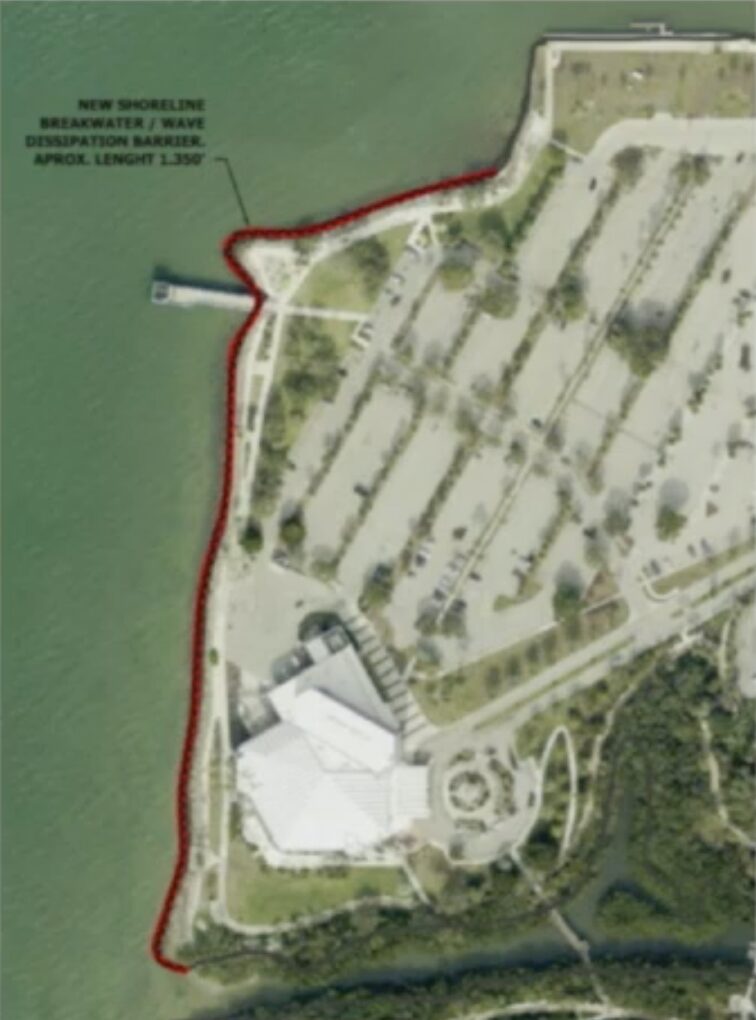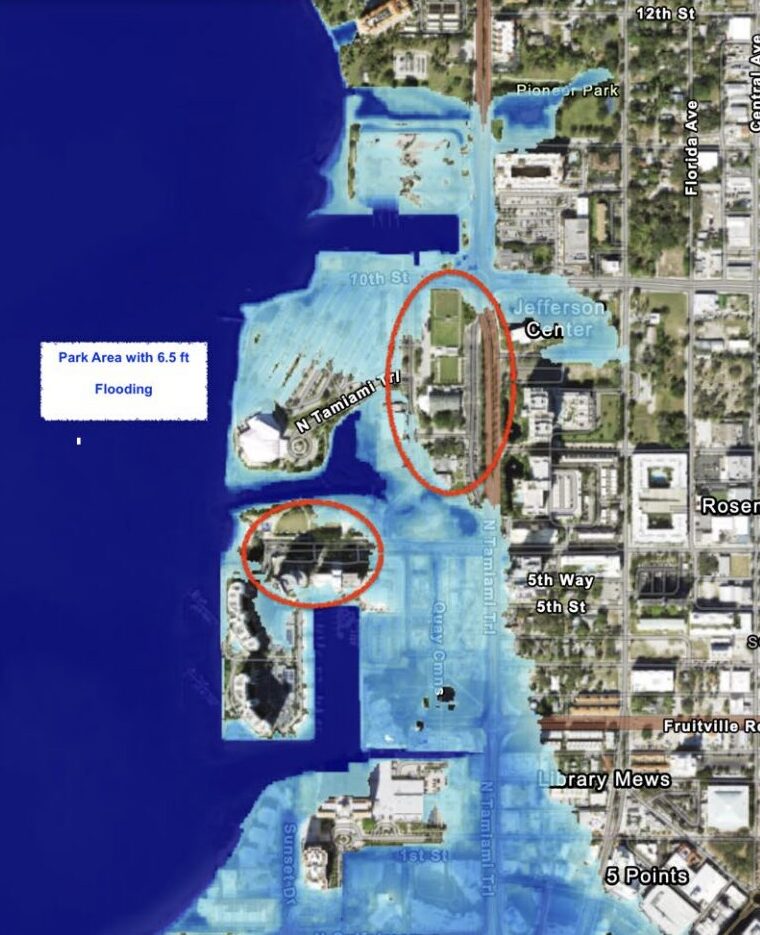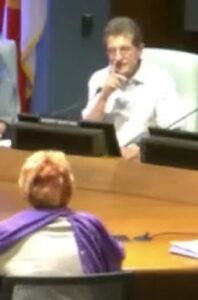Climatologist’s bottom line: Risk could be lowered with a ‘better located’ performing arts center.
By Johannes Werner
Original Air Date: May 2, 2025
Host: The City of Sarasota’s Purple Ribbon Committee has been charged with making recommendations about what to do with the city-owned Van Wezel Performing Arts Hall. Very visible thanks to its purple color, the more than half-century old landmark sits on a mound on the Sarasota bayshore, and—in a reminder of its vulnerability—the basement of the building was flooded last year. This week, a climatologist presented his report on the impacts of climate change on the Van Wezel.

Bob Bunting.
Johannes Werner: Bob Bunting is not only a member of the Purple Ribbon Committee, but he was a lead forecaster for the National Weather Service and participant in global climate programs, and he founded the Sarasota-based Climate Adaptation Center.
Here are some of the points Bunting tried to get across.
In his report, he contends that the climate is changing rapidly, and so are the consequences—specifically the number of storms and their intensity. Last year, both Hurricanes Helene and Milton delivered storm surges of at least six and a half feet. That flooding caused damage to the Van Wezel of more than $10 million.

Aerial photo showing the Van Wezel and a possible new breakwater barrier.
He summarizes the biggest risks for the building as:
- sea-level rise,
- fresh water flooding,
- storm surges and wind, and
- the insurance implications and the downtime for operations that come with all that.
Bunting’s conclusion: We’re better off with a new building elsewhere.
“Although short-term patches can be made to improve short-term viability…, many of these risks can be lowered significantly with the opening of a new better located…Performing Arts Center.…Any reuse…needs to consider the extreme weather, storm characteristics, [rising sea level]…trends and the negative impacts of the westernmost walls of the present building as major inputs to the decision-making process.”
In a previous meeting, the engineering consulting firm hired by the city brought up movable flood barriers—such as the Aqua Fence system that is protecting Tampa General Hospital.
Bunting’s report says the outcomes of the 2024 season provided valuable lessons for the challenges that may lie ahead.

Map generated using NOAA’s Sea Level Rise Viewer at coast.noaa.gov/slr.
One takeaway from that storm season: It does not even take a direct hit by a hurricane to cause major flooding.
“Currently, the risk level has increased because significant damage can occur to shorelines without a direct hit.”
The building is particularly exposed, Bunting’s report says.
It is “highly exposed, sitting just 15 feet from Sarasota Bay. Its long, high waterfront wall, slab foundation, and proximity to rising water levels make it especially vulnerable.” The slab foundation sits at about five feet above sea level.
Another point: The sea wall the Van Wezel needs for protection redirects wave energy and increases the damage caused to the park areas next to it.
Another point: The rising water table impacts the concrete foundation of the building. Each flooding increases the likelihood of a compromised building.
Bunting’s report reproduced a map of the Van Wezel and surrounding area during six-and-half foot flooding. It shows the Van Wezel as an island. The highest ground of the neighborhood is the area along 41 where the municipal auditorium sits.
One of the lively moments of the presentation was a dialogue about insurance between Bunting and Mary Bentsel, the director of the Van Wezel.
Insurance already is a struggle. The venue currently has half a million dollars in deductible for coverage of up to $1 million per incident, Bentsel told the panel. Even though that may not make much financial sense, insurance is needed to remain eligible for more substantial FEMA payouts after damage.
Bob Bunting: As you know, the comment I made was based on—again, I can’t cite this as that we’ve done interviews with insurance companies, although I am working on a big insurance project—but my understanding is that, as time has gone on, the premiums have gone up—

Bunting and Bentsel.
Mary Bentsel: Enormously, in fact. Only one company was willing to write, because I think they’re trying to—when it gets this bad with what your deductions are, they’re looking not to insure you because they’re afraid. And yet the building never had a claim.
BB: You’re just in the high-risk area, and this was the first major claim you’ve—
MB: Yes. And it’s been said to me that we’re the highest-risk building in the city, and now we have had an incursion. But it’s just very unfortunate where the building’s located, based on hurricanes.
BB: Right.
JW: This past storm season gave a taste of what may be ahead. Bentsel said the Van Wezel lost up to $1.3 million in revenues during the post-flood shutdown from October through January. Overall, the impact on operations was $5 million.
Bentsel’s operations manager explained how hard mitigation is. Local vendors refused to install sump pumps in the orchestra pit unless they would be allowed to dig holes into the concrete foundation to make them work appropriately. Also, expensive equipment in low parts of the building will have to be moved eventually. Bentsel:
MB: So many of our dimmer racks and our power supplies are in un-air conditioned areas. They’re right near the water. At the very back of the end, we have a transformer that’s sitting, like, this much. And I want to move the transformer, and Jerry keeps telling me what kind of costs we’re involved with there. He pointed out today we have another transformer sitting in the basement of the Van Wezel, and to move that is also a major, major expense.
JW: Reporting for WSLR News, Johannes Werner.
WSLR News aims to keep the local community informed with our 1/2 hour local news show, quarterly newspaper and social media feeds. The local news broadcast airs on Wednesdays and Fridays at 6pm.